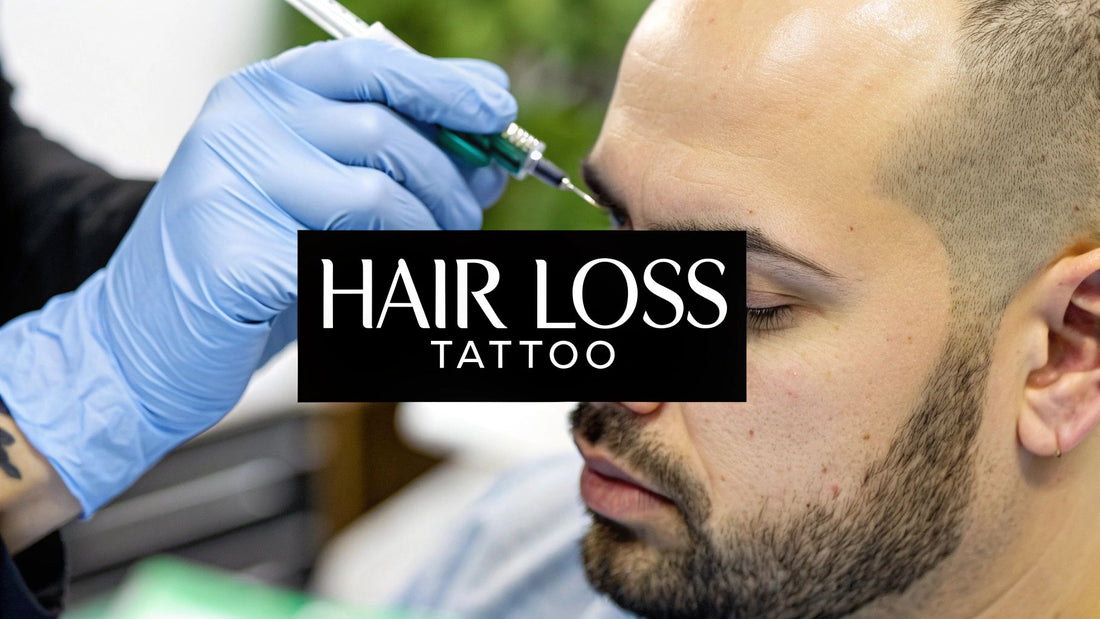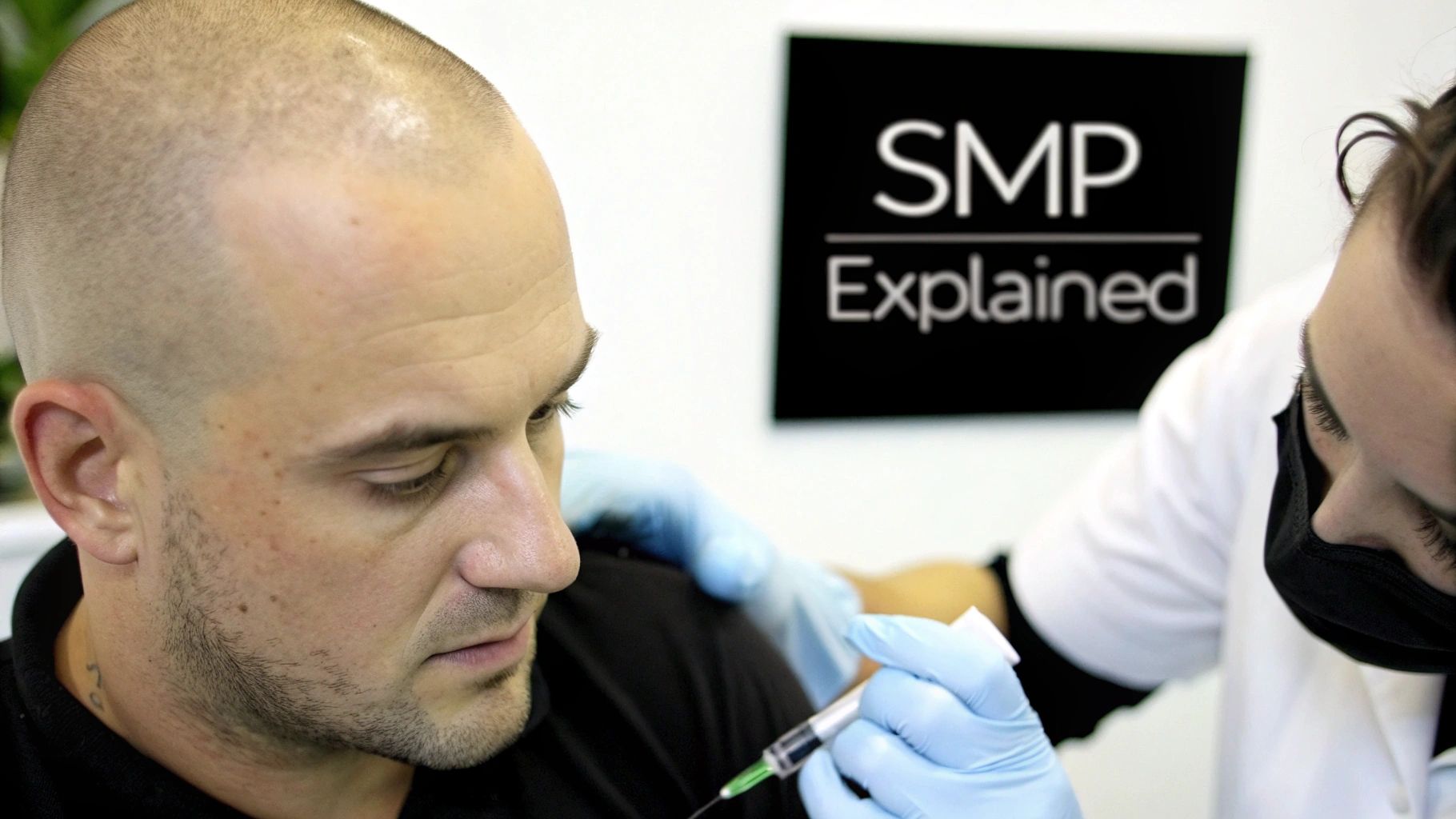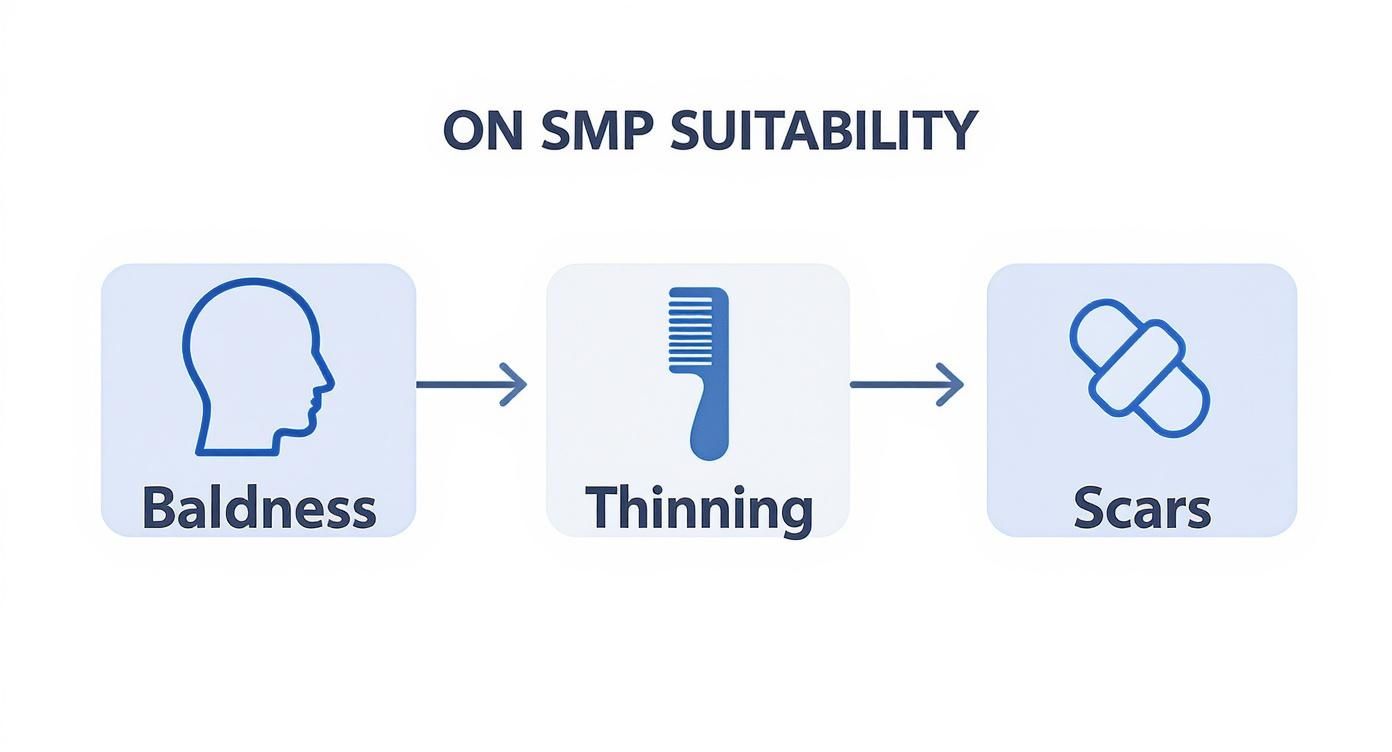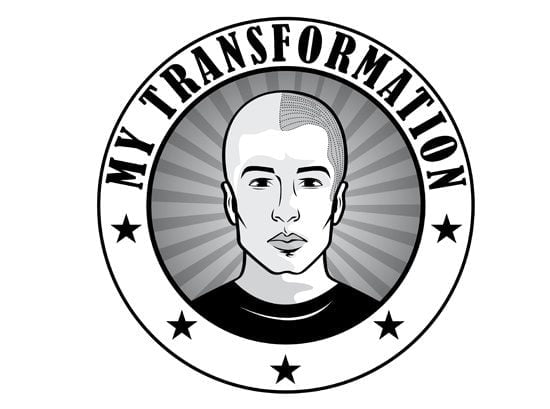
The Ultimate Guide to Hair Loss Tattoo SMP
Share
So, you’ve heard about a hair loss tattoo, but what exactly is it? Think of it less like a traditional tattoo and more like a highly specialised cosmetic treatment. Known in the industry as Scalp Micropigmentation (SMP), this non-surgical procedure cleverly creates the illusion of thicker, fuller hair.
It's an incredibly effective way to tackle everything from general thinning and receding hairlines to concealing bald spots or scars.
Decoding The Hair Loss Tattoo

The best way to picture how SMP works is to imagine an artist using a technique called pointillism—creating a detailed image out of thousands of tiny dots. That's essentially what a hair loss tattoo is. It’s a meticulous process where a trained practitioner uses ultra-fine needles to deposit thousands of tiny pigment dots into the upper layer of the scalp.
This isn't about drawing on hair. Instead, each dot is carefully placed to perfectly replicate an individual hair follicle. When these dots are layered over a few sessions, they blend together to create a remarkably realistic and natural-looking result.
How Does SMP Create A Natural Look?
The magic of a great hair loss tattoo is all in the details. A skilled specialist won't just use a single, flat colour. They'll expertly mix and blend different pigment shades to perfectly match your existing hair and skin tone. This creates a subtle, three-dimensional effect that looks completely authentic, even up close.
The entire treatment is customised to what you want to achieve. It’s incredibly versatile.
- Creating a Buzz Cut: For men with significant balding, SMP can flawlessly replicate the look of a full head of hair that's been shaved down to a sharp, modern buzz cut.
- Adding Density to Thinning Hair: If you're just starting to thin, the pigment can be placed between your existing hairs. This reduces the visible contrast between your hair and scalp, instantly making your hair look denser and fuller.
- Reconstructing Hairlines: SMP is brilliant for rebuilding a receding or uneven hairline. It can frame your face, creating a stronger, more youthful appearance.
- Camouflaging Scars: It’s also a fantastic solution for hiding scars from injuries, accidents, or even previous hair transplant surgeries, making them blend seamlessly into the scalp.
A common misconception is that SMP is the same as a traditional body tattoo. However, SMP uses specialised equipment, needles, and pigments designed specifically for the scalp to ensure the dots remain crisp and don't blur or change colour over time.
A Growing Solution In Australia
What was once a fairly niche treatment has exploded in popularity, becoming a go-to solution for hair loss right across Australia. People are looking for effective, non-surgical options, and SMP delivers. The broader Australian tattoo market, which includes this specialist field, was valued at around AUD 37.16 million and is expected to keep growing.
This surge is all down to its accessibility and, most importantly, its reliable and predictable results. It offers a genuine alternative to other treatments. For a deeper dive, you can learn more about what Scalp Micropigmentation is and how the process works from start to finish.
Ultimately, a hair loss tattoo is a true art form. It's designed to restore not just the appearance of your hair, but the confidence that comes right along with it.
Is a Hair Loss Tattoo Right for You?
So, you’ve seen the incredible before-and-after photos, but is a hair loss tattoo actually the right move for you? It's a fantastic solution for many, but its real magic lies in matching the right person with the right application. Think of it like a perfectly tailored suit – it looks amazing when it’s made for you.
Scalp Micropigmentation (SMP) is often the perfect choice if you're looking for a definitive, no-fuss solution. If you’ve made peace with a sharp, clean-shaven buzz cut or just want to create an underlying shadow to make thinning hair look denser, SMP is brilliant. It gives you a permanent result without the need for daily products or complex routines.
This procedure works wonders across a huge range of hair loss situations. To get a better feel for this, check out our guide on the wide range of individuals who can benefit from hair tattoos.
Who is the Ideal Candidate for SMP?
Let's break down who typically gets the best results from a hair loss tattoo. See if any of these sound familiar.
-
Men with Pattern Baldness: This is the classic SMP candidate. For guys with receding hairlines or thinning on the crown, SMP flawlessly replicates the look of a full head of hair kept in a permanent buzz cut. It’s all about restoring that sharp, strong hairline and framing the face again.
-
Women with Thinning Hair: Women often experience diffuse thinning, which can make the scalp more visible, especially around the parting. SMP adds density by carefully colouring the scalp to reduce that contrast, making the existing hair look instantly thicker and fuller.
-
People with Alopecia: For those with certain types of alopecia, SMP can be truly life-changing. It creates the appearance of a full buzz cut, offering a consistent and reliable look that doesn't depend on unpredictable hair growth.
-
Anyone with Scars: Have a scar from an old injury or a hair transplant (either FUT or FUE)? SMP is an expert at camouflage. A skilled practitioner can blend the scar tissue into the surrounding scalp, making it virtually disappear.
The reality is, male pattern baldness affects up to 95% of Australian men at some point, with many noticing it by age 35. It’s not just a male issue either; female pattern hair loss affects about one in three women. A hair loss tattoo is a long-term fix, with most people enjoying great results for 4–10 years before a simple touch-up is needed. You can read more about these hair loss statistics from Team Micro.
To make it even clearer, here’s a quick checklist to see where you might fit.
Scalp Micropigmentation Suitability Checklist
This table is a simple guide to help you see if SMP aligns with your type of hair loss.
| Hair Loss Condition | Is SMP a Good Solution? | Key Consideration |
|---|---|---|
| Male Pattern Baldness | Excellent | Creates a defined hairline and the look of a full buzz cut. |
| Diffuse Thinning (Female/Male) | Excellent | Adds density by reducing the contrast between hair and scalp. |
| Receding Hairline | Excellent | Rebuilds a natural-looking, stronger hairline. |
| Alopecia Areata (Patchy) | Very Good | Can fill in bald patches effectively. |
| Alopecia Totalis/Universalis | Good | Creates a full buzz-cut look, but expectations must be realistic. |
| Hair Transplant Scars (FUT/FUE) | Excellent | Superb for camouflaging scar tissue and blending it in. |
| Long Hair with Thinning Crown | Very Good | Works as an "undercoat" to make hair appear much thicker. |
Remember, this is just a starting point. A one-on-one consultation is the only way to get a definitive answer.
When SMP Might Not Be the Best Option
Just as important as knowing who SMP is for is knowing when to steer clear. A good practitioner will be upfront about this—honesty and realistic expectations are everything.
It's essential to have a thorough consultation with a qualified practitioner. A true professional will be transparent about whether you are a good candidate and will prioritise your long-term satisfaction over simply making a sale.
Here are a few situations where you should probably reconsider or at least postpone getting a hair loss tattoo:
-
Active Scalp Conditions: If you’re dealing with a flare-up of psoriasis, eczema, or severe dermatitis on your scalp, it’s a no-go. The skin is too inflamed, and the pigment just won't settle correctly. You need to get the condition under control first.
-
Severe or Cystic Acne: Similar to the above, you can't tattoo over active, widespread acne. It's not safe, and the final result will be patchy and uneven.
-
A Tendency for Keloid Scarring: If you know your skin is prone to developing keloids (thick, raised scars), you should avoid SMP. The tiny needle punctures, though minimal, could trigger keloid formation.
Ultimately, the best decision comes from weighing up your goals, your type of hair loss, and the health of your scalp. Your first step should always be a chat with an expert to see if a hair loss tattoo is the perfect solution you've been searching for.
Your Hair Loss Tattoo Journey Step by Step
Knowing what to expect from a hair loss tattoo, often called Scalp Micropigmentation (SMP), can make the whole idea feel a lot less daunting. Think of it not as a single event, but as a carefully planned journey. It’s broken down into a few distinct stages, each one designed to deliver a high-quality, natural-looking result. And it all kicks off with a crucial chat long before any pigment touches your skin.
This infographic gives you a great visual on the common hair loss situations where SMP really shines, from a fully bald head to cleverly hiding scars.

As you can see, SMP is incredibly versatile. It can be tailored to create the illusion of a full buzz-cut, add the look of density to thinning hair, or even camouflage imperfections on the scalp.
The Initial Consultation and Design
This first meeting is, without a doubt, the most important step in your entire SMP journey. It’s a deep dive where you and your practitioner collaborate to map out exactly what you want. You'll go over your hair loss history, your ultimate goals, and the look you're hoping to achieve.
The main event of this session is designing your new hairline. A skilled specialist will use a wax pencil to draw different hairline shapes right onto your scalp. This is a real back-and-forth process. You give your feedback to find the perfect outline—one that suits your face shape, age, and personal style. It's all about creating something that looks natural and makes you feel confident.
This isn't a one-size-fits-all procedure. A great practitioner considers everything from your head shape to your brow line to design a hairline that looks like it's always been there, steering clear of any sharp or unnatural angles.
During this chat, the practitioner will also check out your scalp, find the perfect pigment shade to match your natural hair colour and skin tone, and give you a clear quote for the full treatment. They’ll also answer every single one of your questions, so you feel completely at ease before moving forward.
The Treatment Sessions
The actual hair loss tattoo isn't done in one go. It’s a series of sessions—usually between two to four—with each one lasting about two to four hours. Spacing it out like this is key to building up density gradually, which is what creates that realistic, layered, three-dimensional effect.
Here’s a breakdown of how it typically unfolds:
- Session One: The Foundation. The first session is all about laying the groundwork for your new look. The practitioner applies the initial layer of tiny dots across the entire treatment area. Your scalp will be a bit red afterwards, but this sets the stage for the density that’s built up later.
- Session Two: Adding Density. About a week later, you'll come back for your second session, and this is where the magic really starts to happen. The artist adds more layers of pigment, placing new dots between the ones from the first session. This is what creates that brilliant illusion of fullness and depth.
- Session Three and Four: The Finishing Touches. Any later sessions are all about perfection. The practitioner will fill in any spots that still look a bit sparse, fine-tune the hairline, and make final colour adjustments to ensure a flawless blend. This meticulous finishing process guarantees the final look is seamless from every angle.
Most people describe the feeling as a light, consistent tapping on the scalp—nowhere near as intense as a regular body tattoo. A topical numbing cream is also applied beforehand to make sure you're comfortable the whole time. For a more detailed walkthrough, our guide on the process of getting a hair tattoo takes an even closer look.
Once your final session is done and the short healing period is over, you’re left with a low-maintenance, confidence-boosting solution that looks incredibly real. Your hair loss tattoo journey wraps up with a restored hairline and the appearance of a full, healthy head of hair.
The Pros and Cons of SMP
https://www.youtube.com/embed/tDFeq6MtvoI
Thinking about a hair loss tattoo is a pretty big deal. It’s a fantastic solution for so many people, but it’s really important to look at the whole picture—the good and the not-so-good—before you jump in.
This is all about making sure you’re going in with your eyes wide open. You need to know if Scalp Micropigmentation (SMP) is genuinely the right fit for you, your lifestyle, and what you hope to achieve.
The Major Advantages of a Hair Loss Tattoo
One of the biggest draws for SMP is just how straightforward and non-invasive it is. We’re not talking about surgery here. There are no incisions, no donor sites, and no long, drawn-out recovery. It's a world away from hair transplants, which are major procedures with considerable downtime. SMP is a cosmetic treatment, plain and simple.
Then there’s the instant gratification factor. The moment your final session is done, your new look is complete. You don't have to wait months on end, hoping a treatment will eventually kick in. The appearance of a full head of hair is there immediately, and the confidence boost that comes with it is massive.
Honestly, for a lot of my clients, the best part is the freedom. SMP is unbelievably low-maintenance. You can stop worrying about powders, fibres, or finicky hair systems. Just get up and go. Swim, hit the gym, stand in the rain—it’s not going anywhere.
Here’s a quick rundown of the main perks:
- Guaranteed Results: In the hands of a skilled practitioner, there’s no guesswork. You know exactly what the final result will look like.
- Immediate Visual Impact: You walk out of the clinic with your new hairline sorted, which does wonders for your state of mind.
- Completely Non-Surgical: You get to sidestep all the risks, potential scarring, and recovery time that come with surgical options.
- Low Long-Term Maintenance: All you really need to do is protect it from the sun and maybe pop in for a touch-up every few years. That’s it.
The Potential Downsides and Risks
Let's be real—SMP isn't perfect, and it’s vital to be aware of the potential drawbacks. The absolute number one thing that determines a good or bad result is the skill of your practitioner. A technician who lacks experience can leave you with an unnatural-looking hairline, dots that are too big or placed too deep, or a colour that’s just plain wrong. A bad job can look more like a helmet than hair.
Another thing to consider is the pigment itself. We use specialised pigments designed to hold their colour, but they will fade over time. The sun is the main culprit here. If you’re constantly out in strong sunlight without a hat or good sunscreen, that fading will happen much faster, and you'll need touch-ups more often.
It's also a serious commitment. While we call it semi-permanent because it fades, it won't just vanish on its own. If you ever change your mind and want it gone, the only option is laser removal, which costs money and isn't exactly comfortable. This is why getting the initial design right is so critical.
Here are the key risks to keep in mind:
- Practitioner Skill Varies: The final outcome is 100% dependent on the artist’s ability. A poor job is tough to fix and looks fake.
- Sun Fading: The sun will absolutely lighten your SMP over time. Diligent use of high-SPF sunscreen is non-negotiable if you want it to last.
- Semi-Permanent Nature: This is a long-term decision. You're either committing to the look for years to come or committing to laser removal if you have a change of heart.
- It Doesn't Stop Hair Loss: SMP is a brilliant camouflage, but it doesn’t treat the root cause of your hair loss. If you continue to lose more hair, you might need future sessions to keep the blend looking seamless.
Comparing SMP with Other Hair Loss Solutions
To really get a feel for where SMP fits in, it helps to see it side-by-side with the other options out there. Everyone's situation is different, so what works for one person might not be the best choice for another.
| Feature | Hair Loss Tattoo (SMP) | Hair Transplant (FUE/FUT) | Topical Treatments (e.g., Minoxidil) | Hair Systems (Wigs/Toupees) |
|---|---|---|---|---|
| Result Time | Immediate | 6-12+ months | 3-6 months, results vary | Immediate |
| Invasiveness | Non-invasive | Surgical procedure | Non-invasive topical application | Non-invasive |
| Cost (Initial) | Moderate | High | Low | Moderate to High |
| Maintenance | Very low (sun protection, touch-ups every 4-6 years) | Low post-recovery | Daily application required | High (regular cleaning, re-bonding, replacement) |
| Guaranteed Outcome | Yes, with a skilled practitioner | No guarantee of graft survival | No, results are inconsistent | Yes |
| Best For | Creating density, buzzed look, hiding scars | Restoring actual hair growth in suitable candidates | Slowing hair loss, some regrowth | Providing full coverage instantly, stylistic choice |
| Main Drawback | Doesn't grow hair; practitioner skill is critical | Cost, scarring, long recovery, limited donor hair | Must be used continuously to maintain results | Can look unnatural, requires ongoing maintenance cost |
Putting it all into context is the best way to make a decision you'll be happy with for years to come. Understanding how SMP compares to other solutions is a huge part of that. For a deeper dive, check out our full breakdown of Scalp Micropigmentation vs. other hair loss treatments to see exactly how they all stack up.
SMP Cost and Long-Term Aftercare in Australia

When people start looking into a hair loss tattoo, two questions always come up first: how much will it set me back, and what’s involved in looking after it? It's a fair question. You need to know both the initial investment and the long-term game plan to feel truly confident in your decision.
Think of Scalp Micropigmentation (SMP) as a serious investment in your appearance and confidence. It’s designed to last for years, so it's smart to get the full picture—from how it’s priced to how you’ll protect it from the Aussie sun.
Understanding the Cost of a Hair Loss Tattoo
Let’s get one thing straight: there’s no single, off-the-shelf price for SMP in Australia. The cost is tailored to you, but you can generally expect it to range from $1,200 to over $4,000 for a complete treatment.
So, what drives that price? The biggest factor, by far, is the extent of your hair loss. Someone who just needs to add a bit of density to a thinning crown will naturally pay less than someone who needs a full replication of a hairline across their entire scalp. We often use the Norwood Scale—a universal guide to male pattern baldness—to accurately quote based on the area we need to cover. To get a much deeper dive into the numbers, our guide on scalp micropigmentation cost breaks it all down.
Most professional clinics here will quote you a total package price. This covers all the sessions you'll need (usually two to four) to get the job done right. This approach is much more transparent and means you won't be hit with surprise costs later on—you pay for the finished result, not the hours it takes.
Your Essential Aftercare Timeline
Once your treatment is done, the ball is in your court. Following the aftercare plan your practitioner gives you isn't just a suggestion; it’s absolutely essential for a sharp, long-lasting result.
The first few days are the most crucial. Your scalp needs time to heal and for the pigment to settle in properly.
- First 1–3 Days: Hands off! Don’t touch, wash, or even think about scrubbing your scalp. It’s also a good idea to skip any hardcore gym sessions that’ll make you sweat heavily.
- Day 4 Onwards: You can now give your scalp a gentle rinse with water and a mild shampoo. Just be gentle. And stay out of swimming pools, saunas, and steam rooms for at least another week.
- First 30 Days: The sun is not your friend during this healing phase. Direct, strong sunlight is the number one enemy of fresh pigment. If you have to be outside, a hat is non-negotiable.
Think of your fresh SMP like a delicate photograph. Exposing it to harsh sunlight too early is like leaving that photo on a dashboard in summer—it will fade the colours and ruin the crisp details. Protecting it is the simplest way to ensure its longevity.
Long-Term Maintenance and Touch-Ups
After about a month, your scalp will be fully healed, and looking after your SMP becomes incredibly simple. Your new daily habit? Applying a high-SPF sunscreen (SPF 30+ or 50+) to your scalp. Every single day. Honestly, this one small step will do more to preserve the colour and sharpness of your tattoo than anything else.
Even with the best care in the world, all pigments will lighten slightly over the years. That’s just the nature of it. This is why a quick touch-up is a normal part of the process. Most clients find they come back for a refresh session every four to six years to bring back that original depth and vibrancy. These touch-ups are much quicker and more affordable than your initial treatment—think of it as a simple tune-up to keep you looking your best.
Got Questions About Hair Loss Tattoos? We've Got Answers.
Thinking about a hair loss tattoo? It's natural to have a lot of questions. Let's tackle the big ones – from pain and colour-fastness to what happens when your hair grows or goes grey – so you can feel completely confident about your decision.
So, Does Getting a Hair Loss Tattoo Actually Hurt?
Most people are pleasantly surprised. The sensation is often described as a light, constant tapping, not the sharp pinch you might associate with a regular tattoo.
To make sure you're comfortable, a strong topical numbing cream is applied to your scalp before the artist even begins. You might feel a bit more sensitivity around the temples or the front hairline, but even then, it's completely manageable for almost everyone.
- You're in control: Sessions have built-in break points. If you need a moment to stretch or reapply some numbing cream, just say the word.
- No marathons here: A typical session lasts 2–4 hours, including those pauses, so you won't get fatigued.
- The numbers don't lie: A solid 73% of clients say they only feel mild discomfort during the whole process.
As one client put it, the first hour was noticeable, but once the numbing cream fully kicked in, the feeling faded into the background. For the vast majority, the pain factor is a non-issue.
Will the Pigment Change Colour Over Time?
This is a huge concern for many, and rightly so. Nobody wants a tattoo that turns an unnatural blue or green. Thankfully, SMP uses specialised, carbon-based pigments that are formulated specifically to resist colour shifts.
What you will see is a very slow, natural fading process over many years, where the crisp black dots soften into a charcoal grey. Sun exposure is the main culprit that speeds this up, so think of sun protection as your new best friend.
A Pro Tip: Plan for a quick touch-up every 4–6 years. This keeps the density looking sharp and prevents any areas from looking patchy or faded.
A daily habit of using SPF 30+ sunscreen on your scalp and throwing on a hat when you’re outdoors for long periods will do wonders. This simple care routine is the key to keeping your SMP looking crisp and realistic for years to come.
Can I Grow My Hair Out After Getting SMP?
Absolutely. The pigment is placed in the upper layer of your skin (the dermis), well away from the hair follicles. Your hair will continue to grow exactly as it did before.
When you let your hair grow, the tiny SMP dots blend in with the real strands, creating an incredible illusion of more thickness and density. It gives your hair a much fuller, textured look that’s remarkably natural.
- For added depth: Growing your hair out a little allows the pigment dots and your actual hair to create a layered, three-dimensional effect.
- For the buzz-cut look: If you're going for that clean, sharp stubble look, you'll just need to trim your hair every few days to keep everything seamlessly blended.
Whether you let it grow for density or keep it shaved for a sharp buzz-cut, SMP works with your natural hair to enhance your look.
How Does SMP Work if My Hair Goes Grey?
This is where the artistry really shines. As your hair naturally transitions to grey or "salt and pepper," a skilled SMP artist can adapt your treatment right along with it.
They'll use a customised grey-scale palette, blending in lighter pigments during your touch-up sessions to perfectly match the evolving tones of your hair. This ensures your SMP ages gracefully and naturally with you.
- Do your homework: Ask to see the artist's portfolio of work on older clients to see how well they handle grey blending.
- Stay ahead of it: It's a good idea to schedule a quick colour-check consultation once a year so your artist can make subtle adjustments as needed.
With an experienced practitioner, your hair loss tattoo will remain completely undetectable, even as your hair continues to lighten over the years. It’s all about creating a result that looks real for a lifetime.
Hopefully, these answers have cleared things up and given you the clarity you need before booking your appointment.
My Transformation is here to support your SMP journey. Visit our free consultation booking page to regain confidence in your appearance.
